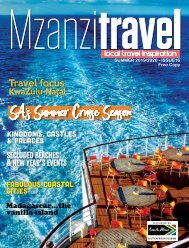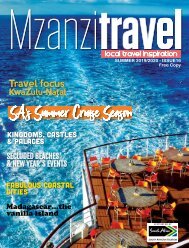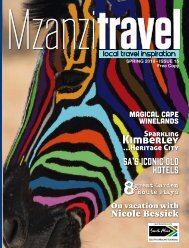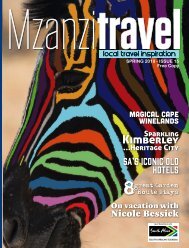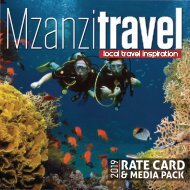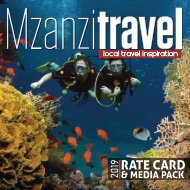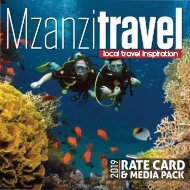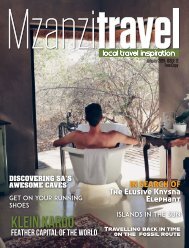Mzanzi Travel - Local Travel Inspiration (Issue 5)
MZANZI TRAVEL is a full-colour quarterly, A4 publication that sets out to showcase, foster and promote whatever South Africa has to offer to both local and international tourists.
MZANZI TRAVEL is a full-colour quarterly, A4 publication that sets out to showcase, foster and promote whatever South Africa has to offer to both local and international tourists.
You also want an ePaper? Increase the reach of your titles
YUMPU automatically turns print PDFs into web optimized ePapers that Google loves.
Cultural <strong>Travel</strong><br />
Over the years the rieldans was also adopted as the dance of farmworkers and<br />
sheep shearers in the Karoo, Namaqualand and other regions, elements of<br />
their daily life and activities being portrayed in some of the dances.<br />
Owing to the original campfire dancing venues in sandy, desert-like rural<br />
settings and the later venues on farms, the dance is today still largely practiced<br />
upon sandy locations. Adding to the electrifying energy of the dance produced<br />
by the fast tempo music and the dance moves, is the kicking up of a veritable<br />
dust storm by the nimble-footed dancers. Many of the dances are still<br />
performed in a circular movement, just as they were by the ancient Khoisan<br />
around their campfires in the dusty veld.<br />
While the riel has survived in relative obscurity over the ages, it enjoyed<br />
much popularity among farm workers and other working class people of the<br />
Northern Cape, Western Cape and Karoo between the 1940s and early 1960s,<br />
after which it started fading away. But it has been placed firmly back on the<br />
national dance stage since 2006 with the assistance of the Afrikaanse Taal- en<br />
Kultuurvereniging (ATKV), or Afrikaans Language and Culture Association, with<br />
dance competitions and sponsorships.<br />
Central to its revival, is Elias P. Nel, a native of Verneukpan in the Kenhardt<br />
district of the Northern Cape region known as Boesmanland, who grew up<br />
with the riel being danced in his area. Many years later he approached the<br />
ATKV which adopted it as one of its many cultural heritage projects and now<br />
organises an annual national rieldans competition, with Elias becoming its chief<br />
organiser, ably assisted by the younger Benjamin Bock.<br />
Thanks to their efforts, today the rieldans is again riding a wave of popularity<br />
in the regions of its inception and beyond, and is danced by people ranging<br />
from toddlers to pensioners. At recent dance competitions more than 80% of<br />
the dancers were under the age of 18, a welcome injection of youth that will<br />
ensure its survival.<br />
Elias says tongue-in-cheek that the rieldans was originally created for people<br />
with rubber knees, long breath and playfulness in the genes (in Afrikaans,<br />
“mense met slap knieë, lang asems en ’n klomp speelsheid in die gene”).<br />
high-energy fancy footwork of the riel. But like the tango, as a dance it strongly<br />
reflects the love ritual with its sexually charged and suggestive moves. Yet it also<br />
goes significantly beyond that.<br />
Whereas the tango originated in the working class courtyards, on the street<br />
corners and in the brothels of Buenos Aires, the riel originated around the<br />
campfires of the Khoisan and Nama after the return of their hunters, after good<br />
harvests or during celebrations. The Nama name for the dance, Ikhapara, was<br />
derived from the word khapas which means ‘hat’, and the hat of a man was<br />
considered a useful article with which to court a woman for her hand in marriage.<br />
Hence the dance also became a dance of love and gave rise to many of the dance<br />
moves still seen today, while hats still form an integral part of the costumes of<br />
male dancers.<br />
These days dance groups with colourful names like Bitterfontein Tradisionele<br />
Dansers, Kamiesbergdansers, Vloedrieldansers, Betjies van Betjiesfontein,<br />
Betjies Rooirots, Griekwa-Ratelgat-rieldansers, Kuierkraal-rieldansers and<br />
Knersvlakte-rieldansers practice their dancing in the towns and villages with<br />
equally colourful names like Pofadder, Loeriesfontein, Garies, Kakamas,<br />
Onseepkans, Pella, Vaalputs, Soebatsfontein and Kamieskroon, where the<br />
dance has survived since the early days.<br />
But the riel is not only practiced with a view to competitions. It is also a common<br />
form of entertainment over weekends in many of the towns within the area of<br />
its original inception.<br />
The rieldans is recognised as an ancient celebratory dance and the oldest<br />
entertainment form used as a social, cultural and educational tool by the<br />
Khoisan people before the arrival of Western cultures and traditions at the<br />
Cape of Good Hope. But as the original Khoi and San languages increasingly<br />
disappeared over time, and the influences of Western culture spread across<br />
the sub-continent, the name Ikhapara became less used and was replaced by<br />
the word riel.<br />
MZANZI TRAVEL| www.mzanzitravel.co.za|ISSUE 5 | 65



